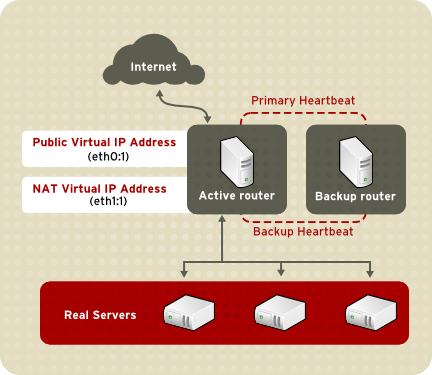1.4. 路由方法
Red Hat Enterprise Linux 在利用可用硬件或者将 LVS 整合到现有网络中时,使用可为管理员提供极大灵活性的网络地址转换或者 NAT 路由。
1.4.1. NAT 路由
复制链接链接已复制到粘贴板!
图 1.3 “LVS Implemented with NAT Routing”, illustrates LVS utilizing NAT routing to move requests between the Internet and a private network.
图 1.3. LVS Implemented with NAT Routing
在本示例中,活跃 LVS 路由器中有两个 NIC。用于互联网的 NIC 在 eth0 中有一个真实 IP 地址,并有一个别名为 eth0:1 的浮动 IP 地址。用于专用网络接口的 NIC 在 eth1 中有一个真实 IP 地址,并有一个别名为 eth1:1 的浮动 IP 地址。在发生失效切换时,面向互联网的虚拟接口和面向虚拟接口的专用接口同时由备用 LVS 路由器取代。所有位于专用网络中的真实服务器为 NAT 路由器使用浮动 IP 地址,因为它们默认路由是和活跃 LVS 路由器沟通,以便不会影响到对来自互联网请求的回应。
In this example, the LVS router's public LVS floating IP address and private NAT floating IP address are aliased to two physical NICs. While it is possible to associate each floating IP address to its own physical device on the LVS router nodes, having more than two NICs is not a requirement.
使用这种布局,活跃 LVS 路由器可接收请求并将其路由到适当的服务器。然后真实服务器处理该请求并将数据包返回到 LVS 路由器,该路由器使用网络地址转换将数据包中的真实服务器地址替换为 LVS 路由器公共 VIP 地址。这个过程被称为 IP 伪装,因为发出请求的客户端无法看到真实服务器的实际 IP 地址。
使用这种 NAT 路由,真实服务器可以是运行各种操作系统的机器。最大的缺点就是在较大群集部署中 LVS 路由器可能会成为瓶颈,因为它必须处理外发和进入请求。
